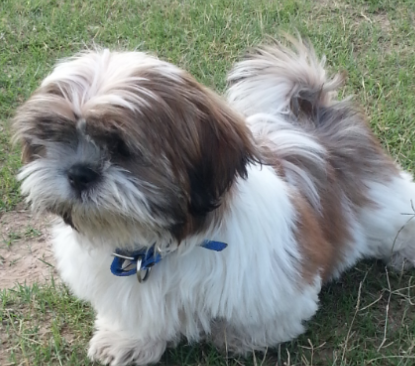Shih Tzu Training and Care
The regal Shih Tzu breed is over a thousand years old, but it has only been known in the West since after WWII. The breed is probably the result of crosses between the Lhasa Apso and the Pekingese at one time. Today the Shih Tzu is extremely popular in the U.S.

History of the Shih Tzu
The earliest record of the Shih Tzu dates to 624 A.D., in the Tang Dynasty when a pair of dogs was given to the Chinese court from what was possibly the Byzantine empire. Other possible sources of the Shih Tzu include Tibet in later centuries. The dogs were bred in Peking and the smallest dogs are said to have looked like a lion. Shih Tzu translates as “lion.” There are several Tibetan holy dogs and the Shih Tzu is said to be the oldest and the smallest of these dogs. The Shih Tzu was kept as a pet during the Ming Dynasty during the 14th to 17th centuries and the royal family favored them. Once they were in China and at the court they were then bred and the Shih Tzu that we have today was created. The Dowager Empress kept a kennel that included Shih Tzu up until 1908 when she died. After this time the dogs were spread out and the organized breeding stopped. The dogs nearly became extinct following the Communist Revolution. Today, all Shih Tzu can trace to just 14 dogs after the revolution, some of which were taken to England. Eventually the breed made its way to the United States and the American Kennel Club first registered them in 1969.
Health
The Shih Tzu is a relatively long-lived breed with an average lifespan of 13 years and two months. It is not unusual for a Shih Tzu to live to be 16 years of age.
Shih Tzu are a brachycephalic breed (short-nosed) and they can have problems with hot, humid weather. They have shorter air passages than dogs with longer muzzles and they should not be exercised when the weather is hot. They will feel the effects of heat and humidity faster than dogs with longer muzzles.
Shih Tzu can have problems with hip dysplasia and portosystemic shunt can be a problem in the breed. Portosystemic shunt occurs when the main vein carrying blood to the liver is not formed properly and the “dirty” blood being carried to the liver for cleaning allows the blood to go elsewhere in the body. This can effect the body’s other organs and be toxic to the body. Fortunately, this condition can be treated with surgery. Symptoms usually appear before the dog is a year old. Luxating patellas (slipped kneecaps) can also be a problem in the breed, as well as some problems with spinal discs because of the breed’s long back.
As with many small breeds, the Shih Tzu can be prone to dental problems. Be sure to brush your Shih Tzu’s teeth regularly to avoid tartar and plaque build up.
Temperament and Training
The Shih Tzu is a gentle and hardy little dog. They are very courageous and lively. They are affectionate and playful and they enjoy being around people. They usually get along well with other pets and they are good with children. Do remember that Shih Tzu are small dogs and they can be easily hurt. If you have small children or rough children, you may want to get an adult Shih Tzu or a larger breed instead of a puppy who could be hurt by rough play. Shih Tzu are very sweet dogs but they are confident and they will stand up for themselves when they need to do so. They are usually friendly with new people but they are also alert dogs and they will bark to let you know you have a visitor. They make a good watch dog.
The Shih Tzu responds well to training but you will need to be patient. They can be hard to housebreak but if you are persistent and patient your dog will learn.
Learn more about our private dog training classes for Shih Tzu adult and puppies. We provide service in Beverly Hills and West LA.
Grooming
The Shih Tzu has a beautiful, long, flowing coat and it requires daily brushing and maintenance when kept in this state. The hair on the head is kept long and pulled up into a topknot which is tied with a bow or clip. The dog does require a lot of grooming if you intend to keep the coat long.
Some pet owners prefer to have the coat cut short in a “puppy clip.” Shih Tzu look very cute in this kind of cut and it is easy to care for. If you have your dog’s coat cut short you should brush the coat about once a week to remove any dead hair that would be shed. You will need to take your dog to a professional pet groomer about every six to eight weeks to have the coat clipped if you choose this style.
Otherwise, you should clean your Shih Tzu’s ears on a weekly basis to avoid ear infections.
Trim your dog’s nails each week to keep them short. If you remove a small amount of nail each week you will avoid cutting your dog’s quicks and you won’t hurt your dog.
Special Needs or Care
The Shih Tzu is a playful, active dog and they need regular exercise. However, remember that they are a brachycephalic breed (short-nosed) which means that they can’t tolerate high heat or humidity. Be particularly careful with your dog in the summer and don’t allow him to exercise in the hottest part of the day.
As an Amazon Associate we earn from qualifying purchases.
